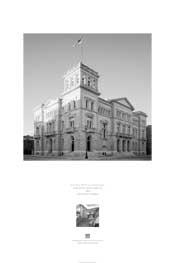Location: 83 Broad St, Charleston, SC 29401
History
The U.S. Post Office and Courthouse in Charleston, South Carolina, is located on the southwest corner of Meeting and Broad Streets in an area known as the “Four Corners of Law.” The building is a testament to the importance of the federal presence in the city. On the northwest corner, a 1792 courthouse represents the role of county government in Charleston. City Hall, built in 1802 on the northeast corner, symbolizes the presence of municipal government. Finally, St. Michael’s Church, built between 1752 and 1761, signifies divine law as a component in community life.
The location of the U.S. Post Office and Courthouse was the site of the gallows for public executions during British rule. After the Revolutionary War, the property was the location for a police guardhouse, which was destroyed during the devastating 1886 earthquake. Officials determined it an ideal site for a new post office and courthouse.
In 1887, Congress authorized funds for construction. South Carolina architect John Henry Devereux designed the building. He was an Irish immigrant who started his career as a plasterer, but soon became a noted architect and builder of churches and public buildings in South Carolina’s Lowcountry. In 1885, Devereux accepted a job as Superintendent of Construction and Repairs of the U.S. Treasury Department, and it was in this capacity that he designed the U.S. Post Office and Courthouse. He selected the Second Renaissance Revival style to convey the grandeur associated with public architecture at that time.
Construction of the building was not finished until 1896 when a gala viewing complete with a German band took place. Completed for a cost of $500,000, the building is credited with playing an important role in the downtown revitalization of Charleston at the end of the nineteenth century.
The building was individually listed in the National Register of Historic Places in 1974, and is also within the boundaries of the National Register Charleston Historic District and the National Historic Landmark Charleston Historic District. Today, the building continues to function as a post office and courthouse.
Architecture
The U.S. Post Office and Courthouse is an excellent example of Second Renaissance Revival architecture. This style conveyed the dignity of government and was often used for civic buildings during the late nineteenth century. Some of the hallmarks of the Renaissance Revival style found on the building include a prominent cornice, balustrades, and quoins (corner blocks). Belt courses, another common feature, encircle the building at each level.
The building is clad in granite quarried from Winnsboro, South Carolina. On the first story, the granite is finished in rock-faced coursed blocks that are slightly darker in tone than the smooth blocks used on the remainder of the building. The quoins also have a rough finish.
Openings on the first story are arched, which is another characteristic of the Second Renaissance Revival style. The second story features rectangular window openings topped with prominent triangular pediments and flanked with pilasters (attached columns). The pilasters are paneled on the bottom, but fluted with parallel, vertical, linear grooves on the top. This pattern continues on pilasters found in the interior lobby. Windows on the third floor are flanked with plain pilasters, but have molded trim above the openings.
Pediments with dentils (square blocks) are centrally located on the top story of the street-front facades. A prominent corner tower that ascends a full story above the rest of the building is located at the confluence of Meeting and Broad Streets. The uppermost story of the tower contains a series of arched windows. The tower is topped with an open balustrade.
The interior contains opulent public spaces, which were restored in 2002. Like the dignified exterior, the interior splendor indicates the importance of public buildings at the end of the nineteenth century. The postal lobby on the first floor appears much as it did when the building opened in 1896. Rich finishes include red Brazilian marble wainscot and floors, and mahogany walls at the sales and box areas. The grand staircase is ornately finished. The same red Brazilian marble is used on the runners and wainscot, but the risers and the railing are ornamented brass. The prominent brass newel posts are topped with finials and connected by mahogany railings. Ornate brass designs with geometric, curvilinear patterns and rosettes are beneath the railings. Massive plaster columns are painted in a faux marble technique to emulate the red marble and rest on hexagonal brass bases. The magnificent effect of these high-quality finishes is distinctive to the Victorian era.
The courtroom on the second floor features many handsome original details, most notably carved woodwork. The room has carved mahogany wainscot and elaborate mahogany window surrounds. A carved mahogany panel with floral and patriotic motifs, including a shield with stars and stripes, is located directly behind the judge’s bench. Oil portraits of past U.S. District judges hang on the walls. On the second and third floors, many original wood-panel doors with mahogany pilasters remain.
In 1922, a modest, single-story, gray concrete addition for service functions was added to the south side of the building. The Hollings Judicial Center was also added to the south side in the 1980s.
Significant Events
- 1887: Funding for new Federal building authorized
- 1896: Construction completed
- 1922: Addition completed
- 1974: U.S. Post Office and Courthouse listed in the National Register of Historic Places
- 1980s: Hollings Judicial Center added
- 2002: Interior restoration
Facts
- Architect: John Henry Devereux
- Architectural Style: Second Renaissance Revival
- Construction Date: 1896
- GSA Building Number: SC0012AC
- National Register of Historic Places Landmark Status: Individually listed in the National Register of Historic Places; Located within the boundaries of the National Register of Historic Places Charleston Historic District and the National Historic Landmark Charleston Historic District
- Primary Material: Granite
- Prominent Features: Corner Tower Postal Lobby Ornate Staircase
Poster Download
Download the poster [PDF - 7 MB]

 U.S. General Services Administration
U.S. General Services Administration
